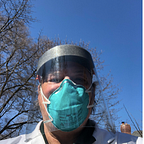The American Medical Association and Boxing
Aversive racism occurs when one shows racist tendencies and behaviors but refuses to believe or accept or understand that such behaviors are racist. I can hear the person say, ”Who me?”
I recall Yogi Berra’s quip, “If you have to tell them, they’ll never get it.”
In 1983 the American Medical Association issued a formal position to ban boxing.
The Journal of the American Medical Association denounced boxing as “an obscenity” and said it should be outlawed. “Boxing as a throwback to uncivilized man, should not be sanctioned by a civilized society,” wrote the journal’s editor Dr. George Lundberg.
I learned that Dr. Lundberg was a pathologist, a ping-pong player, and fired from Journal in 1999 under a cloud of controversy.
Recently an example of aversive racism endemic in the practice of medicine was exposed. Perhaps the American Medical Association should look in the mirror. For almost twenty years the gold standard test for kidney disease, universally used in medical practice, employed a “race modifier” which underestimated the degree of kidney damage in Blacks as opposed to Whites. It has proven to be without merit and harmful. The result was that Black patients were thought to be less seriously ill than Whites which often resulted in a delay of treatment.
The racism was not as blatant or pernicious as The Tuskegee Syphilis Study but certainly affected a greater number of people than the six hundred Black men that were left untreated for syphilis. The numbers involved here are much greater.
I did raise an eyebrow over the race modifier but gave it little thought because it was not relevant to me and my practice. I instinctively ignored it.
The ban on boxing and the willing acceptance of racial modifiers have a common, racist, link.
Amateur boxing was very important to me in 1967.
In 1967 my city, Detroit, experienced a deadly rebellion against racism, specious urban renewal, and police brutality. Forty-three people lost their lives. I lived in an all-white suburb. I needed to understand.
I went downtown and started boxing. At the age of sixteen, I entered the Detroit Golden Gloves boxing tournament where I interacted with Black and Brown kids. We all got along. I learned a lesson in aversive racism early as I always over-prepared when I was to box a Black kid because I thought them to be better boxers. I fought a White kid who gave me a sound whuppin’ and I hung up the gloves and went to medical school.
I never forgot that painful lesson of aversive racism. Now I know it has a name.
Forty years later a man came to my office. He had been a heavyweight contender. We bonded as we talked about boxing. We both knew some of the same fighters from the late sixties and early seventies.
He needed a kidney transplant and I arranged for him to obtain one before going on kidney dialysis. He was Black but I don’t recall being influenced by the race modifier. To use the modifier would have delayed his operation and relegated him to dialysis, deconditioning, and deterioration.
The kidney transplant returned him to robust health. He wanted to give something back to the community. He opened a Detroit boxing gym to train young boys and girls in boxing and to instill honor, honesty, and confidence.
He needed a doctor to work the amateur bouts at ringside and asked me.
I was hesitant as I was aware of the AMA’s position on boxing.
I researched the risk. It turns out that according to the National Safety Council accident report, amateur boxing ranks 23rd on the list of injuries below football, hockey, wrestling, gymnastics, and cheerleading. Why doesn’t the AMA go after those more deadly sports? Aversive racism?
Amateur boxing’s fatality rate is 1.3 per 100,000 compared to college football 3 per 100,000 participants.
To those that say that the goal of football is to move the ball, I bet have never played on the offensive or defensive line and been “pancaked” or “clotheslined” or “horse collared” or had their hand stepped on or bitten. Queensbury rules are absent in football’s trenches. Duffy Daugherty, the late Michigan State football coach said, “Dancing is a contact sport, football is a collision sport.”
So, I became a doctor for amateur boxing in Detroit and Pontiac. I kept it very safe.
The writer and boxing fan Joyce Carol Oates in her essay “On Boxing,” states:
One of the standard arguments for not abolishing boxing is in fact that it provides an outlet for the rage of disenfranchised youths, mainly Backs and Hispanics who can make lives for themselves by way of fighting one and other instead of fighting society
One of our amateur boxers turned professional and amassed a record of 21 wins and one loss. He is to fight for a title in 2022. It is a great opportunity for this young man.
The ban on amateur and professional boxing is another example of aversive racism. Boxing fits the narrative, but the more dangerous sports of football, hockey, basketball, gymnastics, and cheerleading do not. Ban them all, but not just one made vulnerable by the nature of its participants and the prejudice of its detractors.
I think of the young women engaged in gymnastics and the arduous and dangerous physical training which was nothing compared to the emotional toll from the sexual abuse they suffered.
Our young women boxers would knock the pervert into next week.
The life lessons I learned from boxing have been of great value. But at my age I prefer golf, where I protect myself at all times from lightning and sandbaggers.
